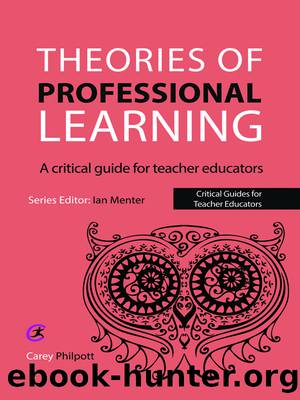Theories of Professional Learning by Philpott Carey;Menter Ian;

Author:Philpott, Carey;Menter, Ian;
Language: eng
Format: epub
ISBN: 1833015
Publisher: Critical Publishing
Published: 2014-08-15T00:00:00+00:00
Figure 6.1 Vygotskyâs tool mediation.
First-generation CHAT has some implications for how we conceptualise learning. We should avoid understanding learning as a self-contained process inside a subjectâs head. Part of the structure and process of learning will come from the cultural and historical context. This means that we should not understand learning as a process that transcends culture and history. Our unit of analysis for learning needs to be the subject in a specific cultural and historical context, engaged in a specific activity so that we can study how the tools of the context mediate the learning. Tools are the products of particular cultures rather than individuals so developing their use is a form of socialisation. We therefore also need to understand learning as a social process, not an individual one.
Figure 6.1 shows two connections between the subject and the object. One, going through the apex, is the connection mediated by the tool. The second, the base, is a direct line between the subject and object. This shows that the subject has two connections to the object: one mediated and one direct. In deer hunting, the hunter has a direct physical relationship with the deer in the same way as a wolf hunting the same deer. However, the mediated connection means that they also have a historically and culturally specific connection.
This mediated connection has conceptual implications for the subject and the object. What does the deer mean and what does it mean to be a hunter within their culture and within the culturally situated activity of hunting? This mediated relationship means that the subject and object in the diagram are not identical with a flesh and blood person and deer. They represent the culturally and historically specific idea or identities of a hunter and deer participating in hunting. The identities of the subject and the object have a reciprocal (dialectical) relationship (Roth, 2004; Roth and Lee, 2007). The identity of the subject influences the identity of the object and vice versa. We cannot understand one without understanding the other. The tool enters into a dialectical relationship too. The identity of the hunter and the deer changes depending on whether the hunter kills the deer at close quarters with a stone axe or from a distance with a rifle. Changes in one part of the triadic relationship create changes in other parts, and each part can only be understood by understanding the others.
The subject, object and tool can also circulate within the relationship (Engeström, 1990; Roth and Lee, 2007). In the example of the scholar, the initial object, an understanding of human behaviour, could become a tool later on to mediate activity in relation to further objects.
Second-generation CHAT
In second-generation CHAT the triad remains but it is augmented by more detailed consideration of the features of the cultural and historical context the activity takes place in and the ways these influence the triad and one another (Figure 6.2)
Figure 6.2 emphasises that activities are collective and involve a community. An activity is not just
Download
This site does not store any files on its server. We only index and link to content provided by other sites. Please contact the content providers to delete copyright contents if any and email us, we'll remove relevant links or contents immediately.
The Art of Coaching Workbook by Elena Aguilar(50168)
Trainspotting by Irvine Welsh(21078)
Twilight of the Idols With the Antichrist and Ecce Homo by Friedrich Nietzsche(18324)
Fangirl by Rainbow Rowell(8819)
Periodization Training for Sports by Tudor Bompa(7947)
Change Your Questions, Change Your Life by Marilee Adams(7405)
This Is How You Lose Her by Junot Diaz(6477)
Asking the Right Questions: A Guide to Critical Thinking by M. Neil Browne & Stuart M. Keeley(5389)
Grit by Angela Duckworth(5322)
Red Sparrow by Jason Matthews(5230)
Paper Towns by Green John(4826)
Room 212 by Kate Stewart(4768)
Ken Follett - World without end by Ken Follett(4468)
The Sports Rules Book by Human Kinetics(4099)
Housekeeping by Marilynne Robinson(4085)
Double Down (Diary of a Wimpy Kid Book 11) by Jeff Kinney(3960)
Papillon (English) by Henri Charrière(3942)
The Motorcycle Diaries by Ernesto Che Guevara(3804)
Exercise Technique Manual for Resistance Training by National Strength & Conditioning Association(3800)
